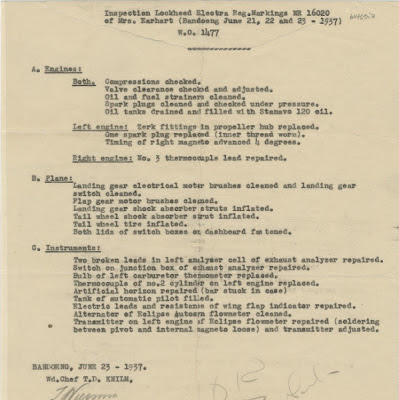These are the words of Amelia Earhart describing this day seventy-five years ago provided by cable and telephone and notes mailed along her way. She also mailed log books as they filled with notes written in pencil from the cockpit as she piloted the Lockheed over four continents.
"On June 1, at 5.56 in the morning,
NR 16020 left Municipal Airport at Miami with Fred Noonan aboard as navigator
and I as pilot, bound for California by about the longest route we could
contrive. At the very last there was a delay while Bo McKneely, my mechanic,
re-soldered a broken thermocouple lead which supplied the cylinder head
temperatures of the left engine. While this went on, all warmed up and plenty
of places to go, we sat for a last breathing spell on the concrete apron beside
the hangar watching the rising sun brush back the silver gray of dawn. The tinkering job completed, back in
place went the cowling.
"Okeh," said Bo. Fred climbed in the cockpit and my
husband, standing alongside on the wing centre-section, leaned in and bade me
good-by. I closed and fastened the hatch. The gathering crowd safely distant
from the propeller blades, ground attendants signalled "All clear."
... Then I started the motors. The engines
had already been well warmed so now after appraising for a moment their
full-throated smooth song, I signalled to have the wheel chocks removed and we
taxied to the end of the runway in the far southeast corner of the field.
thirty seconds later, with comforting ease, we were in the air and on our way.
After the take-off for thirteen
minutes we climbed slowly, swinging on our course toward Puerto Rico.
Shortly after six o'clock two ships
were visible. It was then, with them beneath us, when everything in the cockpit
was properly set and working smoothly, I tuned in on Miami's radio station
WQAM, which was broadcasting every hour a summary of weather conditions which
lay before us, as prepared by Pan American's efficient meteorologists. My own
schedule called for a broadcast every thirty minutes at a quarter past and a
quarter to the hour. I was delayed a little with my first broadcast because
just then the radio station was sending out a description of my own take-off,
which to me was quite too entertaining to miss. The masterpiece was evidently
transcribed from a description made by an announcer at the field. The actual
take-off hour being too early for most civilized stay-a-bed Miamians, the
record was now being played on the air again for their delectation while they
ate their breakfasts and we winged southward.
So, a hundred miles from the field,
the announcer held me in cruel suspense as to whether or not I actually was
going to get off safely! it was diverting to hear that third-person story. In
the manner radio-talk sometimes have, the account of the very normal departure
had become breathlessly exciting. ...
At
about noon Navigator Noonan told me we were too far south and I changed my
course as directed. At the moment there was nothing to see but indistinguishable
sea and sky. And then suddenly through a haze we sighted Puerto Rico. That was
just after noon....
Following along the shoreline we
came soon to the airport, close beside the colourful city of San Juan."
visit http://butthisisdifferent.com to enter a different Amelia reality.
In the photograph Amelia and Fred Noonan prepare to leave San Juan.





































